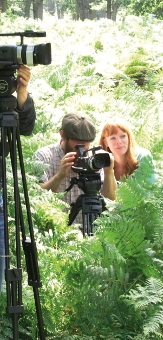| Julia Charlotte Richter

Foto: Jan Bode
play time, 2008
8'40'', 1-Kanal-Videoprojektion, loop, DV-PAL
"Geheimnisse sind ein Spiel,
das zugleich zeigt und verbirgt."
Max van Manen und Bas Levering, Kindheit und
Geheimnisse, Bad Heilbronn: Klinkhardt, 2000.
- - - - - - - - - - - - - - - - - - - - - - - - - - - - -
„I have grown to love secrecy. (...) The commonest thing is
delightful if one only hides it. (...)...somehow it seems to bring
a great deal of romance into one’s life."
Oscar Wilde, The Picture of Dorian Gray, New York: Tor Book, 1999.
- - - - - - - - - - - - - - - - - - - - - - - - - - - - -
„I have but a field or two to traverse, and then I shall cross the road
and reach the gates. How full the hedges are of roses! But I have no
time to gather any... (...) ...a winding walk, bordered with laurels and
terminating in a giant horse-chestnut...While such honeydew fell,
such silence reigned, such gloaming gathered, I felt as if I could haunt
such shade for ever... I see trees laden with ripening fruit. I hear a
nightingale warbling in a wood half a mile off: no moving form is
visible, no coming step audible...I make for the wicket leading to the
shrubbery, and I see Mr Rochester entering...and he strolls on, now
lifting the gooseberry-tree branches to look at the fruit, large as
plums, with which they are laden; now taking a ripe cherry from the
wall, now stooping towards a knot of flowers, either to inhale their
fragrance or to admire the dew-beads on their petals. A great moth
goes humming by me; it alights on a plant at Mr Rochester’s foot...“
„...sitting by him, roused from the nightmare of parting
- called to the paradise of union – I thought only of the bliss given
me to drink in so abundant a flow. And what ailed the chestnut
tree? It writhed and groaned; while wind roared in the laurel walk,
and came sweeping over us.“
----
„Descending the laurel walk, I faced the wreck of the chestnut-
tree. It stood up, black and riven: the trunk, split down the centre,
gasped ghastly. The cloven halves were not broken from each other,
for the firm base and strong roots kept them unsundered below;
though community of vitality was destroyed – the sap could flow
no more...“
Aus: Charlotte Brontës Jane Eyre, 1847, in: Charlotte Brontë, Jane Eyre, London: Penguin Books,
1994.
- - - - - - - - - - - - - - - - - - - - - - - - - - - - -
Der Haubenfink (Roter Kronfink)
Familie: Traupidae (Ammerntangaren)
Unterfamilie: Tachyphoninae (Kardinaltangaren)
Gattung: Coryphosphingus
Art: Cucullatus
Unterart: cucullatus (Roter Kronfink)
Verbreitung / Lebensraum
Die Heimat des Roten Kronfinken ist Südamerika. Er kommt von Guayana und dem nördlichen Teil Brasiliens über Uruguay bis hin zum östlichen Teil Argentiens (etwa bis Buenos Aires) vor. Sein bevorzugter Lebensraum sind offenen Landschaften mit viel Buschbewuchs, wie zum Beispiel im Buschwald, Waldränder, Parkanlagen, verwilderte Gärten und Gewässer. Dort lebt er im Gebüsch versteckt und hält sich viel am Boden auf.
Beschreibung / Aussehen
Länge : ca. 13-14 cm
Männchen:
feuerroter Streifen entlang des Scheitels, eingefasst von schmalen schwarzen Streifen, kann zu einer Haube aufgestellt werden; Kopf, Kehle, Brust und Bauch weinrot; Kinn weißlichrot; Oberseite dunkel rotbraun; Bürzel rot; Schwingen und Schwanz braun; Augen dunkelbraun, von einem weißen Lidring eingefasst; Oberschnabel hornbraun, Unterschnabel weißlich hornfarben; Füße dunkelbraun
Weibchen:
insgesamt brauner als das Männchen; ohne rot und Schwarz am Kopf, keine Haube; Kinn weißlich; Füße und Schnabel heller als beim Männchen
Lautäußerungen
Den Gesang des Roten Kronfinken zu beschreiben ist nicht so einfach möglich, da er sich aus verschiedenen zwitschernden, trillernden und zirpenden Elementen zusammensetzt, die mit Worten schlecht zu beschreiben sind. Der Kontakt- und Warnruf, der von beiden Geschlechtern vorgetragen wird, lässt sich als scharfes “Zwick” beschreiben.
aus: http://www.ulli-hartmann.de/index.php?page=798

| 